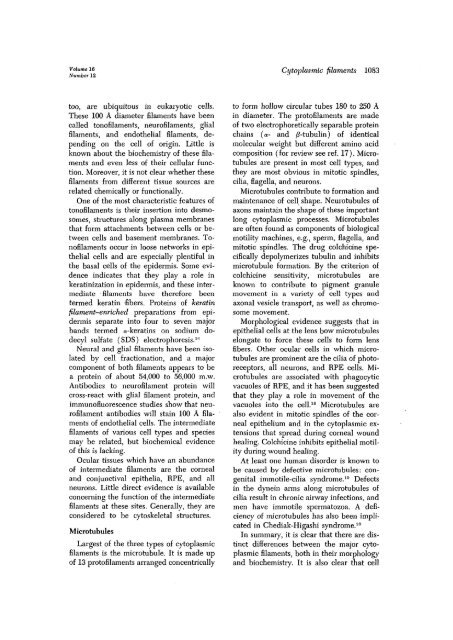Cytoplasmic filaments - Investigative Ophthalmology & Visual Science
Cytoplasmic filaments - Investigative Ophthalmology & Visual Science
Cytoplasmic filaments - Investigative Ophthalmology & Visual Science
Create successful ePaper yourself
Turn your PDF publications into a flip-book with our unique Google optimized e-Paper software.
Volume 16<br />
Number 12<br />
<strong>Cytoplasmic</strong> <strong>filaments</strong> 1083<br />
too, are ubiquitous in eukaryotic cells.<br />
These 100 A diameter <strong>filaments</strong> have been<br />
called tono<strong>filaments</strong>, neuro<strong>filaments</strong>, glial<br />
<strong>filaments</strong>, and endothelial <strong>filaments</strong>, depending<br />
on the cell of origin. Little is<br />
known about the biochemistry of these <strong>filaments</strong><br />
and even less of their cellular function.<br />
Moreover, it is not clear whether these<br />
<strong>filaments</strong> from different tissue sources are<br />
related chemically or functionally.<br />
One of the most characteristic features of<br />
tono<strong>filaments</strong> is their insertion into desmosomes,<br />
structures along plasma membranes<br />
that form attachments between cells or between<br />
cells and basement membranes. Tono<strong>filaments</strong><br />
occur in loose networks in epithelial<br />
cells and are especially plentiful in<br />
the basal cells of the epidermis. Some evidence<br />
indicates that they play a role in<br />
keratinization in epidermis, and these intermediate<br />
<strong>filaments</strong> have therefore been<br />
termed keratin fibers. Proteins of keratin<br />
filament-enriched preparations from epidermis<br />
separate into four to seven major<br />
bands termed a-keratins on sodium dodecyl<br />
sulfate (SDS) electrophoresis. 1 ' 1<br />
Neural and glial <strong>filaments</strong> have been isolated<br />
by cell fractionation, and a major<br />
component of both <strong>filaments</strong> appears to be<br />
a protein of about 54,000 to 56,000 m.w.<br />
Antibodies to neurofilament protein will<br />
cross-react with glial filament protein, and<br />
immunofluorescence studies show that neurofilament<br />
antibodies will stain 100 A <strong>filaments</strong><br />
of endothelial cells. The intermediate<br />
<strong>filaments</strong> of various cell types and species<br />
may be related, but biochemical evidence<br />
of this is lacking.<br />
Ocular tissues which have an abundance<br />
of intermediate <strong>filaments</strong> are the corneal<br />
and conjunctival epithelia, RPE, and all<br />
neurons. Little direct evidence is available<br />
concerning the function of the intermediate<br />
<strong>filaments</strong> at these sites. Generally, they are<br />
considered to be cytoskeletal structures.<br />
Microtubules<br />
Largest of the three types of cytoplasmic<br />
<strong>filaments</strong> is the microtubule. It is made up<br />
of 13 proto<strong>filaments</strong> arranged concentrically<br />
to form hollow circular tubes 180 to 250 A<br />
in diameter. The proto<strong>filaments</strong> are made<br />
of two electrophoretically separable protein<br />
chains (a- and /3-tubulin) of identical<br />
molecular weight but different amino acid<br />
composition (for review see ref. 17). Microtubules<br />
are present in most cell types, and<br />
they are most obvious in mitotic spindles,<br />
cilia, flagella, and neurons.<br />
Microtubules contribute to formation and<br />
maintenance of cell shape. Neurotubules of<br />
axons maintain the shape of these important<br />
long cytoplasmic processes. Microtubules<br />
are often found as components of biological<br />
motility machines, e.g., sperm, flagella, and<br />
mitotic spindles. The drug colchicine specifically<br />
depolymerizes tubulin and inhibits<br />
microtubule formation. By the criterion of<br />
colchicine sensitivity, microtubules are<br />
known to contribute to pigment granule<br />
movement in a variety of cell types and<br />
axonal vesicle transport, as well as chromosome<br />
movement.<br />
Morphological evidence suggests that in<br />
epithelial cells at the lens bow microtubules<br />
elongate to force these cells to form lens<br />
fibers. Other ocular cells in which microtubules<br />
are prominent are the cilia of photoreceptors,<br />
all neurons, and RPE cells. Microtubules<br />
are associated with phagocytic<br />
vacuoles of RPE, and it has been suggested<br />
that they play a role in movement of the<br />
vacuoles into the cell. ls Microtubules are<br />
also evident in mitotic spindles of the corneal<br />
epithelium and in the cytoplasmic extensions<br />
that spread during corneal wound<br />
healing. Colchicine inhibits epithelial motility<br />
during wound healing.<br />
At least one human disorder is known to<br />
be caused by defective microtubules: congenital<br />
immotile-cilia syndrome. 19 Defects<br />
in the dynein arms along microtubules of<br />
cilia result in chronic airway infections, and<br />
men have immotile spermatozoa. A deficiency<br />
of microtubules has also been implicated<br />
in Chediak-Higashi syndrome. 20<br />
In summary, it is clear that there are distinct<br />
differences between the major cytoplasmic<br />
<strong>filaments</strong>, both in their morphology<br />
and biochemistry. It is also clear that cell
















